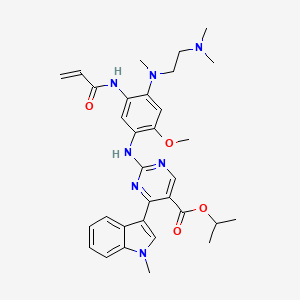



API Suppliers

US DMFs Filed
0

CEP/COS Certifications
0

JDMFs Filed
0
Other Certificates
0
Other Suppliers
0

USA (Orange Book)

Europe
0

Canada
0

Australia
0

South Africa
0
Uploaded Dossiers
0
U.S. Medicaid
Annual Reports
0
0


1. Propan-2-yl 2-(4-(2-(dimethylamino)ethyl-methylamino)-2-methoxy-5-(prop-2-enoylamino)anilino)-4-(1-methylindol-3-yl)pyrimidine-5-carboxylate
2. Tak-788
1. 1847461-43-1
2. Tak-788
3. Ap32788
4. Tak788
5. Mobocertinib [inn]
6. Ap-32788
7. Mobocertinib [usan]
8. 39hbq4a67l
9. Isopropyl 2-((5-acrylamido-4-((2-(dimethylamino)ethyl)(methyl)amino)-2-methoxyphenyl)amino)-4-(1-methyl-1h-indol-3-yl)pyrimidine-5-carboxylate
10. Propan-2-yl 2-[4-[2-(dimethylamino)ethyl-methylamino]-2-methoxy-5-(prop-2-enoylamino)anilino]-4-(1-methylindol-3-yl)pyrimidine-5-carboxylate
11. 1-methylethyl 2-[[4-[[2-(dimethylamino)ethyl]methylamino]-2-methoxy-5-[(1-oxo-2-propen-1-yl)amino]phenyl]amino]-4-(1-methyl-1h-indol-3-yl)-5-pyrimidinecarboxylate
12. Exkivity
13. 5-pyrimidinecarboxylic Acid, 2-((4-((2-(dimethylamino)ethyl)methylamino)-2-methoxy-5-((1-oxo-2-propen-1-yl)amino)phenyl)amino)-4-(1-methyl-1h-indol-3-yl)-, 1-methylethyl Ester
14. Propan-2-yl 2-(5-(acryloylamino)-4-((2-(dimethylamino)ethyl)(methyl)amino)-2-methoxyanilino)-4-(1-methyl-1h-indol-3-yl)pyrimidine-5-carboxylate
15. Mobocertinib (tak788)
16. Mobocertinib(tak-788)
17. Unii-39hbq4a67l
18. Mobocertinib [who-dd]
19. Chembl4650319
20. Schembl17373133
21. Gtpl10468
22. Bdbm368374
23. Dtxsid201336749
24. Bcp31045
25. Ex-a3392
26. Us10227342, Example 10
27. Xyc46143
28. Mfcd32669806
29. Nsc825519
30. S6813
31. Tak-788;ap32788
32. Who 11183
33. At30193
34. Nsc-825519
35. Ac-36436
36. Example 94 [wo2015195228a1]
37. Hy-135815
38. Cs-0114256
39. D81621
40. A934607
41. Tak-788;tak 788; Tak788; Ap32788; Ap-32788; Ap 32788
42. Isopropyl 2-(5-acrylamido-4-((2-(dimethylamino)ethyl)(methyl)amino)-2-methoxyphenylamino)-4-(1-methyl-1h-indol-3-yl)pyrimidine-5-carboxylate
| Molecular Weight | 585.7 g/mol |
|---|---|
| Molecular Formula | C32H39N7O4 |
| XLogP3 | 4.4 |
| Hydrogen Bond Donor Count | 2 |
| Hydrogen Bond Acceptor Count | 9 |
| Rotatable Bond Count | 13 |
| Exact Mass | 585.30635275 g/mol |
| Monoisotopic Mass | 585.30635275 g/mol |
| Topological Polar Surface Area | 114 Ų |
| Heavy Atom Count | 43 |
| Formal Charge | 0 |
| Complexity | 935 |
| Isotope Atom Count | 0 |
| Defined Atom Stereocenter Count | 0 |
| Undefined Atom Stereocenter Count | 0 |
| Defined Bond Stereocenter Count | 0 |
| Undefined Bond Stereocenter Count | 0 |
| Covalently Bonded Unit Count | 1 |
Mobocertinib is indicated for the treatment of adult patients with locally advanced or metastatic non-small cell lung cancer (NSCLC) with epidermal growth factor receptor (EGFR) exon 20 insertion mutations whose disease has progressed on or after platinum-based chemotherapy.
Mobocertinib is an inhibitor of EGFR that preferentially targets exon 20 insertion mutant variants. It is available as an oral capsule taken with or without food once daily. Mobocertinib can cause a concentration-dependent increase in QTc interval which may lead to life-threatening complications such as Torsades de Pointes. Patients with baseline risk factors for QTc prolongation should consider alternative medications or be monitored carefully throughout therapy. The use of concomitant QTc-prolonging medications should be avoided, as should concomitant inhibitors of CYP3A, as these may increase the concentration of mobocertinib and thus the risk of QTc-prolongation.
Absorption
The mean absolute bioavailability of mobocertinib is 37% and the median Tmax is approximately 4 hours. Following a single oral dose of 160mg of mobocertinib to fasted patients, the mean Cmax and AUC0-inf were 45.8 ng/mL and 862 ngh/mL, respectively.
Route of Elimination
Following oral administration of mobocertinib, approximately 76% of the administered dose was recovered in the feces (6% as unchanged parent drug) with only 4% recovered in the urine (1% as unchanged parent drug). The metabolite AP32960 comprised 12% and 1% of the recovered dose found in the feces and urine, respectively, while the metabolite AP32914 was below the detection limit in both.
Volume of Distribution
The mean apparent volume of distribution of mobocertinib was approximately 3,509 L at steady-state.
Clearance
At steady-state, the mean apparent oral clearance of mobocertinib and its two active metabolites, AP32960 and AP32914, was 138 L/hr, 149 L/hr, and 159 L/hr, respectively.
Mobocertinib is metabolized primarily by CYP3A enzymes to two active metabolites, AP32960 and AP32914, which are equipotent to mobocertinib and account for 36% and 4% of its combined molar AUC, respectively.
At steady-state, the mean elimination half-life of mobocertinib and its two active metabolites, AP32960 and AP32914, was 18 hours, 24 hours, and 18 hours, respectively.
The epidermal growth factor receptor (EGFR) is a transmembrane receptor that regulates signaling pathways in the control of cellular proliferation. Mutations in these proteins have been associated with certain types of lung cancer, including non-small cell lung cancer (NSCLC). While the majority of _EGFR_ mutations associated with NSCLC involve the _EGFR_ L858R point mutation or exon 19 deletions (referred to as "classical" _EGFR_ mutations), less common _EGFR_ exon 20 insertion mutations carry a particularly poor prognosis and are associated with resistance to standard targeted EGFR inhibitors. Mobocertinib is an inhibitor of EGFR that irreversibly binds to and inhibits EGFR exon 20 insertion mutations at lower concentrations than wild-type EGFR proteins, exerting a pharmacologic effect on mutant variants at concentrations 1.5- to 10-fold lower than on wild-type proteins.


